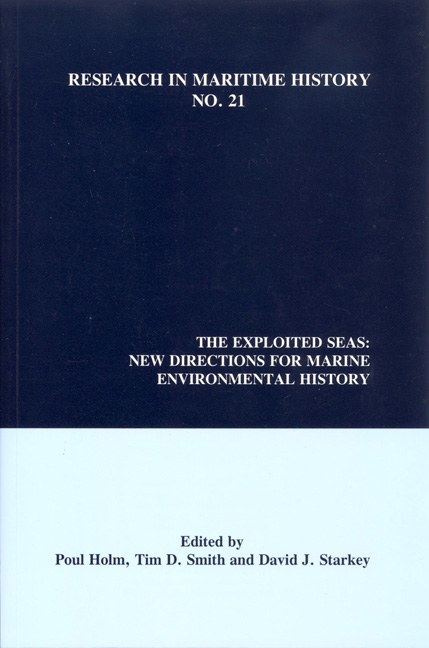Book contents
- Frontmatter
- Contents
- About the Editors
- Contributors
- “Introduction”
- Contributions
- “The Newfoundland Fisheries, c. 1500-1900: A British Perspective”
- “Testing Ecological Models: The Influence of Catch Rates on Settlement of Fishermen in Newfoundland, 1710-1833”
- “Nineteenth-Century Expansion of the Newfoundland Fishery for Atlantic Cod: An Exploration of Underlying Causes”
- “Status and Potential of Historical and Ecological Studies on Russian Fisheries in the White and Barents Seas: The Case of the Atlantic Salmon (Salmo Salar)”
- “The Danish Fisheries, c. 1450-1800: Medieval and Early Modern Sources and Their Potential for Marine Environmental History”
- “Historical Approaches to the Northern California Current Ecosystem”
- “Potential for Historical-Ecological Studies of Latin American Fisheries”
- “The South African Fisheries: A Preliminary Survey of Historical Sources”
- “The Potential for Historical Studies of Fisheries in Australia and New Zealand”
- “Examining Cetacean Ecology Using Historical Fishery Data”
“The South African Fisheries: A Preliminary Survey of Historical Sources”
from Contributions
- Frontmatter
- Contents
- About the Editors
- Contributors
- “Introduction”
- Contributions
- “The Newfoundland Fisheries, c. 1500-1900: A British Perspective”
- “Testing Ecological Models: The Influence of Catch Rates on Settlement of Fishermen in Newfoundland, 1710-1833”
- “Nineteenth-Century Expansion of the Newfoundland Fishery for Atlantic Cod: An Exploration of Underlying Causes”
- “Status and Potential of Historical and Ecological Studies on Russian Fisheries in the White and Barents Seas: The Case of the Atlantic Salmon (Salmo Salar)”
- “The Danish Fisheries, c. 1450-1800: Medieval and Early Modern Sources and Their Potential for Marine Environmental History”
- “Historical Approaches to the Northern California Current Ecosystem”
- “Potential for Historical-Ecological Studies of Latin American Fisheries”
- “The South African Fisheries: A Preliminary Survey of Historical Sources”
- “The Potential for Historical Studies of Fisheries in Australia and New Zealand”
- “Examining Cetacean Ecology Using Historical Fishery Data”
Summary
Abstract
Commercial exploitation of marine resources in southern African historically has concentrated on the west coast of the continent, where the Benguela upwelling current produces a super-abundance of particular species. Over the past 200 years, whales (from c. 1785), snoek (from c. 1840), guano (from c. 1845), rock lobster (from c. 1890), hake (from c. 1940) and pilchard (from c. 1945) have fuelled successive boom-bust cycles along the coast between the Cape Peninsula and the mouth of the Kunene River. Conversely, the south and east coasts, where the warm Agulhas Current nurtures a greater diversity of marine species, but at much lower population densities, sustained only subsistence and small-scale artisanal fisheries until the second half of the twentieth century. This essay is concerned with historical records relating to the exploitation of the marine resources of the west coast/Benguela, reflecting the greater commercial importance of the west over the south and east coast fisheries. It is intended as a survey of published work that utilises historical material (defined for present purposes as pre-1945 data series). It should also be noted that, although not discussed here, the subsistence/artisanal fisheries of the Natal coast are very well documented for the period 1897-1929.
Generation and Context of Historical Records
The systematic collection of statistics was a comparatively late development in southern Africa. The first population census was only conducted in 1865, while the initil annual agricultural census was completed in 1888 and the first annual industrial census took place in 1916. Systematic marine research in the region was initiated by the Cape colonial state in 1896 with the appointment of a marine biologist, but this position was abolished due to budget constraints in 1906. The Cape provincial administration, charged with fisheries management at Union, revived the marine biologist's post in 1911 and “shared” the incumbent with the national Department of Mines and Industries - which initiated its own marine biological survey in 1920 - until his death in 1926. Thereafter, official marine research was the preserve of the national government, which took over administrative responsibility for the economically-important Cape marine fisheries in 1936-1940 and established a Division of Fisheries under the Department of Commerce and Industries in 1937. The latter remains the state's marine research arm today, despite a bewildering array of name and departmental affiliation changes over the intervening sixty years.
- Type
- Chapter
- Information
- The Exploited SeasNew Directions for Marine Environmental History, pp. 167 - 180Publisher: Liverpool University PressPrint publication year: 2001

